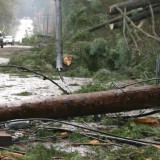The chainsaws are still snarling weeks after the windstorm of March 12, 2012, busily cutting up the thousands of trees that blew down in forests, fields, roadsides and yards. Firewood seems to be the preferred fate for most of these once stately trees. Most of them will probably just decay on the ground where they have fallen, although some of the larger ones may become lumber. With this exception, they are all examples of feedback.
Two principal dynamics are at work in the global warming process that is changing the planet’s climate. The first is “forcing”. This is the term climatologists use to describe the initial heating effect of the gases we emit into the atmosphere. The best known of these is carbon dioxide — about 33.5 billion tonnes of it per year now come from our burning of fossil fuels. Methane, also a significant influence and about 20 times more potent than CO2, escapes from oil and natural gas wells, garbage dumps and untreated sewage. Other less known gases such as hydrofluorocarbons also contribute their influence. Another forcing process is deforestation, our deliberate removal of forests for fibre, lumber, agriculture, roads, urban sprawl, right-of-ways or any other purpose.
The dynamics of forcing are fairly clearly understood. And we can correct its damaging effect on climate simply by reducing or stopping the offending emissions. “Feedback”, however, is a more complicated problem. It is the consequence of forcing, a process that is potentially much more dangerous because it sets in motion conditions that are beyond our control once we have initiated the global warming.
As the temperature of the atmosphere rises from forcing, secondary event begin to accelerate the warming. Carbon dioxide, for example, dissolves in the ocean to form carbonic acid, and the increasing acidity impairs the growth of the phytoplankton that transform CO2 into oxygen. Higher levels of CO2, therefore, handicap the process that is absorbing and reducing the problem gas. A similar effect occurs with terrestrial plants. They, too, absorb CO2. But temperatures and levels of CO2 beyond a certain threshold begin to slow growth and impede carbon dioxide uptake. Feedback, therefore, accelerates the warming process.
Other worrisome feedbacks also occur. Melting ice and snow in polar regions expose water and land to the warming effect of sunlight. Without the reflective cover of white, the so-called albedo effect, more surface heating increases the melting which, in turn, melts more ice and snow, thus causing more heating. This is why polar regions are warming at two to four times the rate at lower latitudes.
More feedback trends are occurring in polar regions. As permafrost melts, huge amounts of methane are released. In classical feedback fashion, the escaped methane heats the atmosphere, causes more permafrost to melt and releases more methane to melt even more permafrost. Similarly, cold and pressure hold vast quantities of methyl hydrates in solid storage at the bottom of northern oceans. As these oceans warm, the hydrates effervesce, release methane and heat the atmosphere to add even more warmth to the ecosystems.
Lay critics of climate change theory often confuse forcing with feedback. In the complex subject of global climate change, one misunderstanding has been clarified for deniers by the astute reply of a climatologist who made the simple distinction between forcing and feedback. Cloud formation is known to cause warming because it reflects radiant heat back to earth — this is why clear nights are usually cooler than cloudy ones. Deniers argue that the warming process is simply caused by more clouds. Clouds, however, are the result of atmospheric humidity. And higher temperatures increase the activity of the hydrological cycle. As greenhouse gases force up temperatures, humidity increases, clouds become more prevalent, and they become feedback that accelerates the warming.
These are examples of “positive feedback” — results we don’t want. But “negative feedback” can also occur to slow the global warming process. Volcanos are the best natural example. When millions of tonnes of sulphates and particles explode into the atmosphere by a huge eruption, the gas and debris reflect sunlight back into space. The planet can cool for years or decades, sometimes by as much as 2°C — some eruptions may have shifted the climate balance enough to initiate ice ages.
We can cause the same cooling effect by adding specific pollutants to the atmosphere. Climatologists noted a sudden and inexplicable rise in global temperatures during the 1980s, a rise that couldn’t be explained by the increase in greenhouse gas emissions. The spike in temperature was caused by efforts to reduce air pollution from the world’s factories and coal-burning thermal plants. The reduction in atmospheric sulphates and soot cleaned the air and accelerated planetary heating. The same process occurred during the days immediately following the 9/11 terrorist attacks in the US. With all passenger planes grounded over North America, the skies cleared of contrails and particulates, causing a surge in regional temperatures.
But most feedback is positive, amplifying the effect of forcing. Windstorms topple trees. Downed trees can no longer sequester carbon from the atmosphere and replace it with oxygen. Decaying wood releases carbon dioxide and methane that become net contributors to the problem of global warming. So the snarl of chainsaws is more than just the simple aftermath of a windstorm.


I am really tired of people who point to imaginary dangers:
http://wattsupwiththat.com/2012/03/31/2011-us-tornado-year-analyzed-no-trend-indication-still-below-1974/
when the “Climate Change” meme is being used as the reason to instal a killer electric grid. The latest news is not only is it a soft kill microwave weapon, but it is hackable and could easily be crashed leading to unimaginable chaos and loss of life.
http://www.financialpost.com/markets/news/Hacking+Expert+David+Chalk+Joins+Urgent+Call+Halt+Smart+Grid/6447539/story.html
Congratulations for saving us from a few more parts per million of the beneficial trace gas CO2 and setting us up for a Mad Max World.